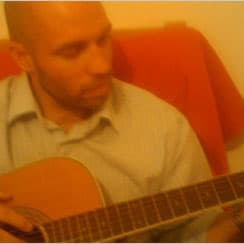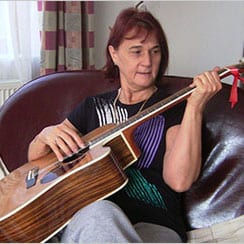Harmonics are played every time you pluck a note, you just don’t hear them most of the time. What you hear is the fundamental (sometimes called the first harmonic), which is the loudest sound you get when you simply play a fretted note. Nevertheless, it is accompanied by harmonics. When you play harmonics on the guitar, you eliminate the fundamental sound, therefore you can actually hear the harmonic.
There are several ways to play harmonics, and it is important to understand the physics behind harmonics.
Natural Harmonics (Open-String Harmonics)
To play a natural harmonic, you need to place your finger lightly on the string at given positions of the guitar. It is important that you place your finger over the metal fret itself, not where you would fret the note, and just touch the string slightly as if you wanted to mute the string.
The most common places to play natural harmonics are at fret 12, fret 7, and fret 5.

Tips on getting a better sound when playing natural harmonics
- Use just the tip of your fretting hand finger.
- Try switching between pickups if you are playing an electric guitar, to see which one sounds the best with harmonics.
- Also, turn on the distortion, as it really accents the harmonic notes.
How natural harmonics work
Harmonics are all about string length. When you use your finger to produce a harmonic, you modify how the string vibrates. When you use your finger to produce a harmonic, you are actually splitting the string into halves, thirds, fourths, and so on.
- Playing the harmonics at the 12th fret split the string in half.
- Playing at the 7th or 19th fret split the string into thirds (notice how the fret 7 and fret 19 natural harmonics give exactly the same note).
- Playing at fret 5 and 24 will split into fourths, etc. and so on.
To put it into comparison, when you fret a note normally, the string is ringing from that fret to the bridge. When you play a natural harmonic at the 12th fret, for example, the string is actually ringing on both sides of where you are touching. The only part of the string that is not ringing is where you were touching the string, which point is called the node. The string is ringing in 2 divided sections.
Playing this doubles the frequency of the string as compared to the open string, since you cut the ringing part into half, and as you know, doubling the frequency of any note results in the same note, one octave higher.

Playing a natural harmonic at frets 7 and 19 cuts the string into thirds:

And playing it at fret 5 cuts it into fourths:

The notes you get by playing the natural harmonics are as follows:
| Mode | Length Fraction | Fret | Note |
|---|---|---|---|
| 1 | 1 | open | unison |
| 2 | 1/2 | 12 | octave |
| 3 | 1/3, 2/3 | 7, 19 | octave + perfect fifth |
| 4 | 1/4, 3/4 | 5, 24 | 2nd octave |
You can actually play the E minor pentatonic scale using only natural harmonics, try it out:

Artificial Harmonics (Fretted Harmonics)
Artificial harmonics, as opposed to natural harmonics, require fretting notes with your fretting hand.
Artificial harmonics can be heard about 12 frets up from where you are fretting, so if you hold down a string at fret 3 for example, you will be able to hear its artificial harmonic at fret 15.
Try this as an example:
- Hold down fret 3 on the low E string with your fretting hand
- Touch the string lightly with the tip of your finger above the 15th fret with your index finger, as you learned with natural harmonics
- Pluck the string closer to the bridge with another finger (middle, ring)
- Alternatively, you could be holding your pick as you normally would between your thumb and index finger, touch the side of your thumb against the string, and pick at it while touching it
Pinch Harmonics
Playing pinch harmonics is a rather advanced technique, that’s difficult to master, but can vastly increase your lead guitar skills.
A pinch harmonic, also referred to as a squealie or squealer is a technique where your thumb or index finger (on the picking hand) slightly catches the string after it is picked, cancelling the fundamental of the string, thereby sounding its harmonic.
A pinch harmonic is achieved by holding your pick so that only 3-4mm of its tip protrudes between the thumb and forefinger, allowing the thumb to brush the string immediately after it is picked. This has to be done at a node, and will deaden the fundamental, leaving only the harmonic.
Pinch harmonics requires great timing and coordination, since you will be touching the string at a node, and plucking it at exactly the same time. As you know, practice makes perfect, so practice this technique as well.




